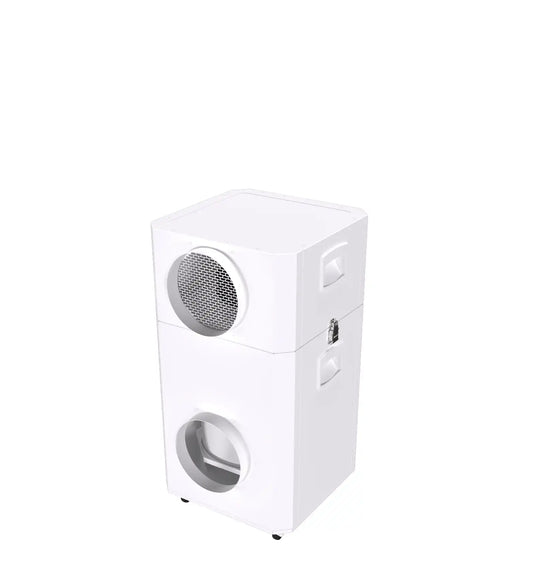Air Purifiers in Hospital and Healthcare Settings.

Air purifiers utilising HEPA filters (High-Efficiency Particulate Air) have become commonplace in hospitals and healthcare facilities with the primary aim of reducing airborne transmission of SARS-coV-2. The benefits of portable air filtration in hospitals include lowering room-to-room transmission and making areas safer for staff and patients.
With air purifiers gaining popularity in healthcare settings it’s important to take a closer look at filtration efficiency to ensure these devices function as intended with the highest possible capture rate for aerosols containing SARS-coV-2 or other pathogens.
Filtration Efficiency
At its most basic level, an air purifier is only going to perform as well as the filters inside. When you are dealing with filtering viruses from the air, you need to select an air purifier with a medical-grade HEPA filter. Medical-grade refers to top-tier H13 or H14 efficiency-rated filters that will capture a minimum of 99.95-99.99% of particles @ 0.3 microns (PM 0.3) or larger. These are the same filters relied upon in infection control isolation rooms and operating theatres.
HEPA Filter Types
HEPA air purifiers commonly use either a synthetic pleated HEPA type filter or medical-grade, EN1822-rated HEPA paper.
HEPA ‘type’, commonly synthetic filters are made from polypropylene media with an electrostatic charge, the charge improves filter efficiency so the filter media will let through fewer particles. Synthetic filter media is used for 2 reasons; it’s lower cost to manufacture and it creates less pressure drop, so the fan in the air purifier can be smaller.
The electrostatic charge on the filter media essentially magnetises the filter material to hold and capture more dust and particles, however, the caveat is the charge dissipates over time and causes the efficiency to reduce. In tests we have performed on synthetic filters we have seen a reduction from 99.95%, down to less than 75% during six months of use.

Synthetic filters usually cannot be certified as some ultrafine particles will penetrate the filter and therefore fail the stringent EN1822 efficiency tests. By contrast, HEPA paper, also known as glass paper, maintains the same very high efficiency for the life of the filter.
HEPA Air Purifier Selection Criteria
A common misconception in healthcare procurement is that all HEPA air purifiers are similar, the main assessment criteria for purchasing are based on system price, availability and how much are ongoing filter replacement costs.
Air purifiers available from electrical retailers are typically sold to consumers for their homes for dust and allergen removal and are not engineered for demanding healthcare environments.
Unfortunately, as mentioned above the term "HEPA" is used by all manufacturers, it's up to the purchaser to determine what standards the manufacturer has engineered the filter to comply with.
Below are the 8 different classes defined under EN1822 and their filtration efficiency. Efficiency is determined by removal rates of the most penetrating particle size (MPPS).
|
Filter Class (EN 1822) |
Filter Class (ISO 29463) |
Overall Efficiency (%) |
|
E11 |
ISO 15 E |
≥ 95 |
|
E12 |
ISO 25 E |
≥ 99.5 |
|
H13 |
ISO 35 H |
≥ 99.95 |
|
H14 |
ISO 45 H |
≥ 99.995 |
|
U15 |
ISO 55 U |
≥ 99.9995 |
|
U16 |
ISO 65 U |
≥ 99.99995 |
|
U17 |
ISO 75 U |
≥ 99.999995 |
EN1822 is a more stringent standard that tests the efficiency of the actual filter. A filter will either pass or fail the test.
Most viruses are estimated to be 0.1-0.125 microns in size; H13/H14 HEPA is effective in filtering approx. 95% or greater of particles @ 0.1 microns. Airborne viruses are usually spread when the virus is aerosolised in fine droplets in the air and these are typically 0.5 microns in size and larger.
Clean Air Delivery Rate (CADR)
Clean Air Delivery Rate, also known as ‘CADR’, is a home air purifier standard developed by the Association of Home Appliance Manufacturers in the US.
CADR measures reductions in certain particle sizes and smoke in a test chamber over 10 minutes. It was not intended to be used for applications involving SARS-coV-2 reduction of aerosols.
As with other commercial air filtration applications, filter test classifications including ISO and EN1822 provide a more reliable means of guaranteeing filter efficiency and knowing what the actual efficiency of the filter is.
Synthetic filters mentioned above provide good performance in CADR tests because the filter is only being tested for minutes, long-term performance can be significantly reduced and the end user will not be aware of this unless they are using a laser particle counter to measure the filter efficiency.
Key Points
- The majority of air purifiers are not medical-grade filters (H13/H14 efficiency) and contain synthetic filters with lower E11 - E12 efficiencies.
- Buyer Beware: synthetic HEPA-type filters using materials like polypropylene do not maintain the stated efficiency for the life of the filter, HEPA paper is the only material guaranteed to maintain efficiency for the life of the filter. Synthetic filters use an electrostatic charge on the filter material which assists efficiency but over time the charge is lost and so is the efficiency.
- Bigger is better: the larger the size of the filter surface area (usually measured in m2) increases the efficiency of the filter due to a larger contact area. When comparing air purifiers look for the largest filter in size.
- The Clean Air Delivery Rate (CADR) advertised by many mass-produced air purifiers is not indicative of overall filtration efficiency.
- Air purifiers that direct airflow in all directions tends to recirculate their air at lower speeds making them less effective.
Please click here to view the InovaAir V-Series Air Purifiers designed for virus risk reduction.














